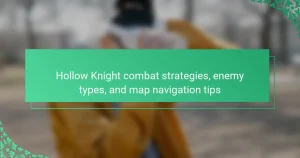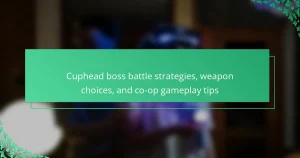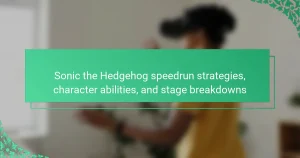Shovel Knight offers a rich gameplay experience through precise platforming, strategic relic usage, and diverse enemy encounters. Players navigate challenging levels while utilising relics for unique abilities. Understanding enemy patterns is essential for effective combat strategies. Mastering these mechanics enhances overall performance and enjoyment in the game.
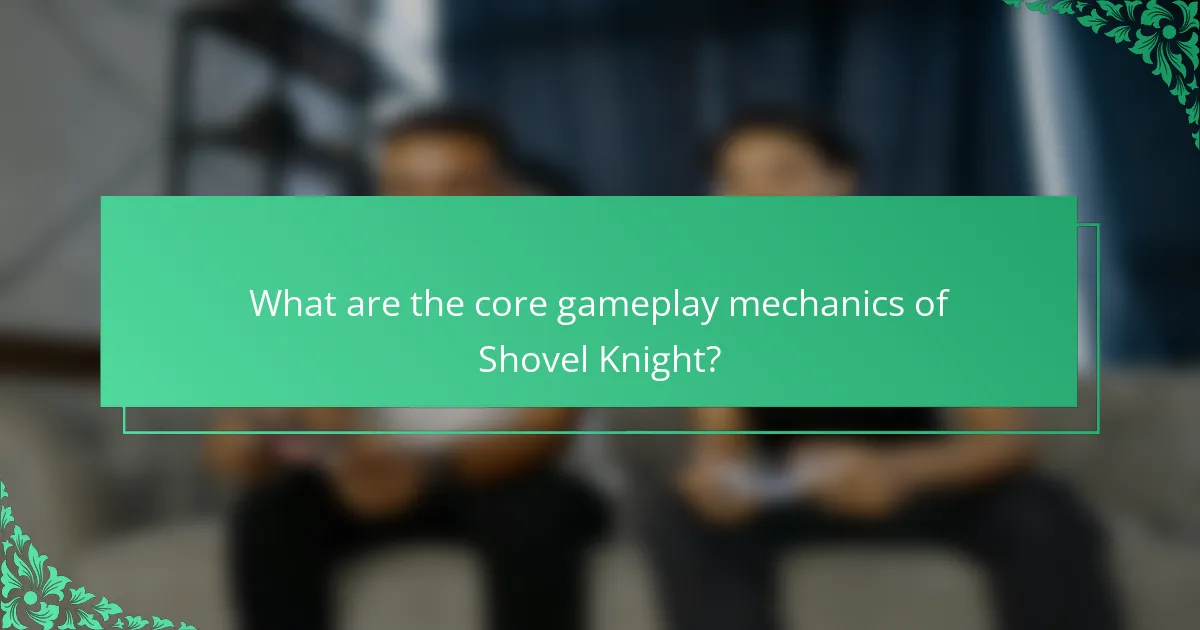
What are the core gameplay mechanics of Shovel Knight?
Shovel Knight features engaging gameplay mechanics centred around precise platforming, relic usage, and strategic enemy encounters. Players navigate levels filled with traps and obstacles while utilising relics for unique abilities.
Relics serve as powerful tools, providing options like healing or projectile attacks. Players must choose relics wisely based on their playstyle and the challenges they face. Enemy encounters require players to adapt their strategies, as each foe has distinct attack patterns and weaknesses.
The game emphasises skillful timing and movement, rewarding players for mastering its mechanics. This blend of exploration, combat, and relic strategy creates a rich gameplay experience that keeps players engaged throughout their adventure.
How do movement and jumping mechanics influence gameplay?
Movement and jumping mechanics significantly enhance gameplay by influencing player control and enemy interaction. In Shovel Knight, precise jumping allows players to navigate levels effectively and avoid hazards. The game’s mechanics reward timing and strategy, as players can utilise relics to modify their movement. For instance, the Propeller Dagger enables vertical mobility, altering how players engage with the environment and enemies. This dynamic interplay between movement and relic usage creates a rich gameplay experience, requiring players to adapt their strategies based on the mechanics at hand.
What role does combat play in player progression?
Combat is crucial for player progression in Shovel Knight, enhancing skills and unlocking relics. Engaging enemies provides experience and rewards, allowing players to acquire new abilities. Each combat encounter offers unique challenges, requiring strategic use of relics. Mastery of combat mechanics leads to improved performance and exploration of the game’s world.
How do platforming challenges enhance the gaming experience?
Platforming challenges significantly enhance the gaming experience in Shovel Knight by introducing dynamic gameplay mechanics. These challenges require precise timing and skill, engaging players actively. Relic usage adds strategic depth, allowing players to adapt their approach based on enemy encounters. For example, the ability to use relics like the Phase Locket provides temporary invincibility, changing how players navigate difficult sections. The combination of platforming and combat creates a rich, immersive experience that keeps players invested in their journey.
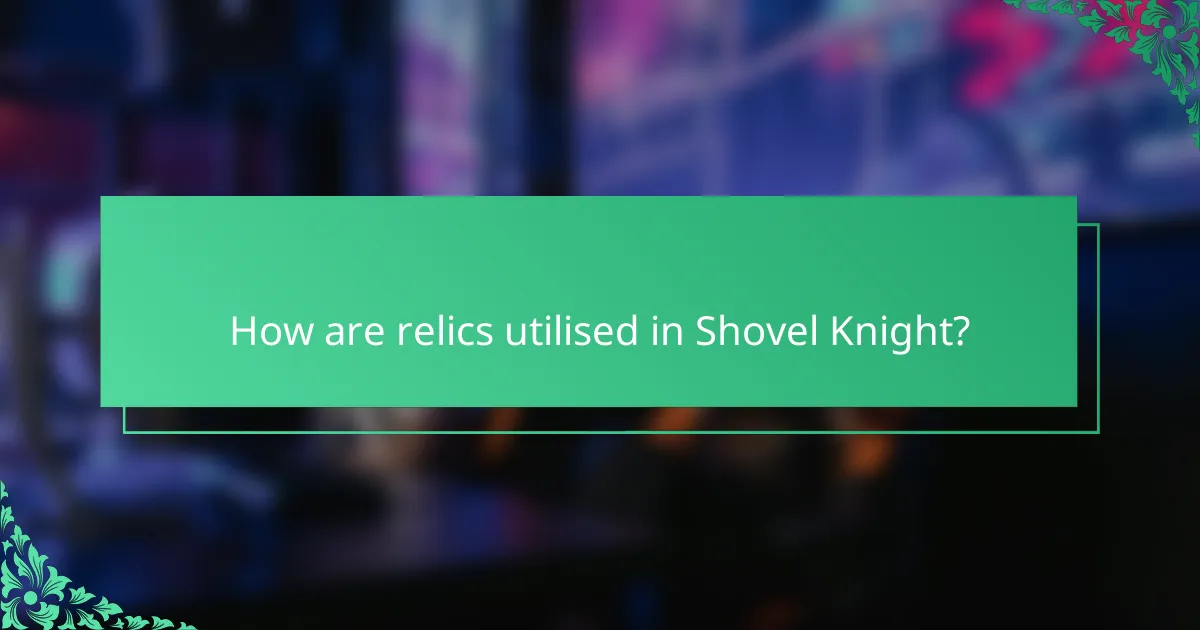
How are relics utilised in Shovel Knight?
Relics in Shovel Knight serve as unique tools that enhance gameplay by providing various abilities. Players can equip relics to gain advantages in combat and exploration. For example, the Phase Locket allows invincibility for a short duration, while the War Horn summons a powerful ally. Each relic has specific attributes that influence its effectiveness in different enemy encounters. Players must strategically choose relics to complement their playstyle and tackle challenges throughout the game.
What types of relics are available and their functions?
Shovel Knight features various relics that enhance gameplay and combat effectiveness. These relics include the War Horn, which stuns enemies, and the Flare Wand, allowing players to unleash fireballs. Each relic serves unique functions that aid in navigating levels and defeating foes. Additionally, some relics can be upgraded for increased potency or new abilities.
How do players acquire and upgrade relics?
Players acquire and upgrade relics by defeating enemies, collecting gems, and visiting specific locations. Relics enhance gameplay by providing unique abilities or advantages. Players can purchase relics from merchants or find them hidden in levels. Upgrading relics requires collecting specific resources, which can be obtained through exploration or defeating bosses. Each relic has distinct attributes that affect its performance, such as cooldown time or damage output.
Which relic strategies are most effective in different levels?
The most effective relic strategies in Shovel Knight vary by level and enemy type. Players should adapt their relic usage based on the challenges presented in each stage.
In the early game, the Health Restore relics, like the Meal Ticket, are crucial for survival. They provide immediate benefits, allowing players to sustain their health during challenging encounters. As players progress, relics like the Phase Locket become essential for avoiding damage from tough enemies and bosses.
In the mid-game, players should utilise the War Horn to deal damage to multiple foes, especially in crowded areas. This relic enhances offensive capabilities and is effective against swarms of weaker enemies.
In the late game, the use of the Anchor relic is advantageous for precision attacks against powerful bosses. Its unique ability to deal damage from a distance can turn the tide in difficult battles.
Overall, understanding the strengths and weaknesses of each relic in relation to specific levels and enemy encounters is key to mastering Shovel Knight’s gameplay mechanics.
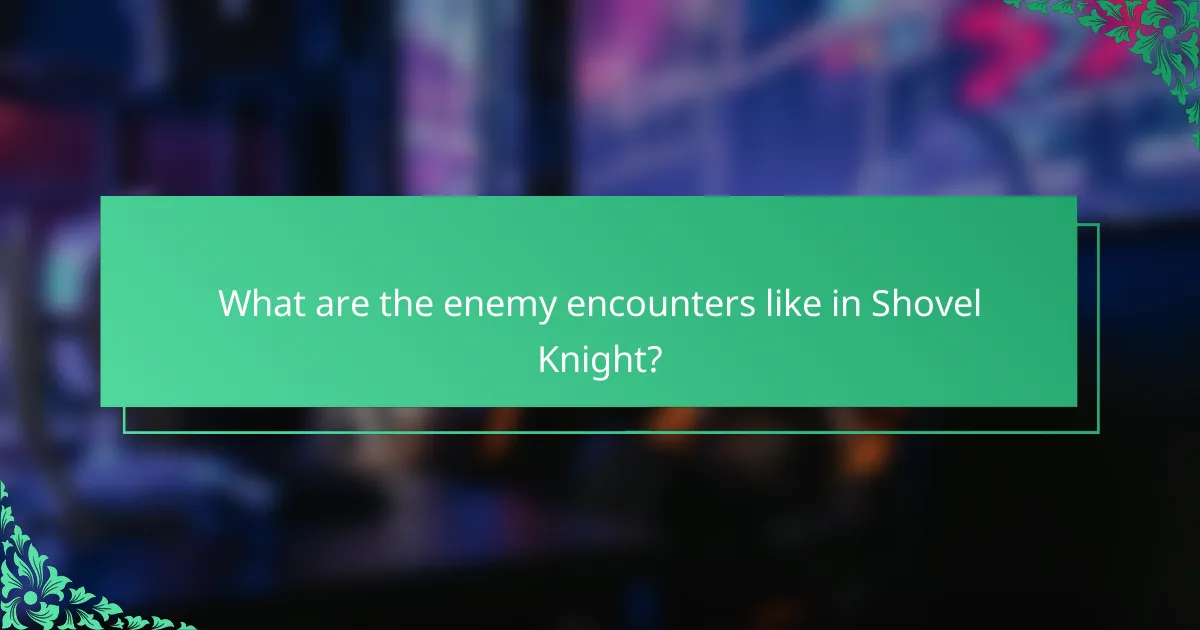
What are the enemy encounters like in Shovel Knight?
Enemy encounters in Shovel Knight are diverse and strategically designed. Players face a variety of foes, each with unique attack patterns and abilities. The game features mini-bosses and larger enemies that require different strategies to defeat. Relics play a crucial role in these encounters, offering players advantages such as temporary invincibility or ranged attacks. The unique attribute of enemy design enhances gameplay, making each encounter memorable and challenging.
How do enemy types vary across different regions?
Enemy types in Shovel Knight vary significantly across regions, each presenting unique challenges. For instance, the Plains feature basic foes like the Knight, while the Lair introduces elemental enemies such as Fire and Ice creatures. The Forest showcases agile foes that require different strategies to defeat. Additionally, each region’s enemies may have distinct attack patterns and health levels, influencing player tactics and relic usage. This variation enhances gameplay depth and encourages exploration of different combat styles.
What strategies can players use to defeat challenging enemies?
Players can defeat challenging enemies in Shovel Knight by mastering gameplay mechanics and effectively using relics. Timing is crucial; players should learn enemy attack patterns to dodge and counterattack. Utilising relics, such as the Phase Locket for invincibility or the Super Bouncy Boots for high jumps, can create strategic advantages. Additionally, players should explore the environment for power-ups and upgrades to enhance their abilities and health. Combining these strategies allows for a more effective approach to enemy encounters.
How do boss battles differ from regular enemy encounters?
Boss battles in Shovel Knight are more complex and strategic than regular enemy encounters. Bosses have unique attack patterns, larger health pools, and require players to utilise specific relics effectively. Unlike regular enemies, which often rely on straightforward tactics, bosses challenge players to adapt and develop strategies to exploit their weaknesses. Each boss encounter is designed to test the player’s mastery of the game’s mechanics, making them a pivotal part of the gameplay experience.
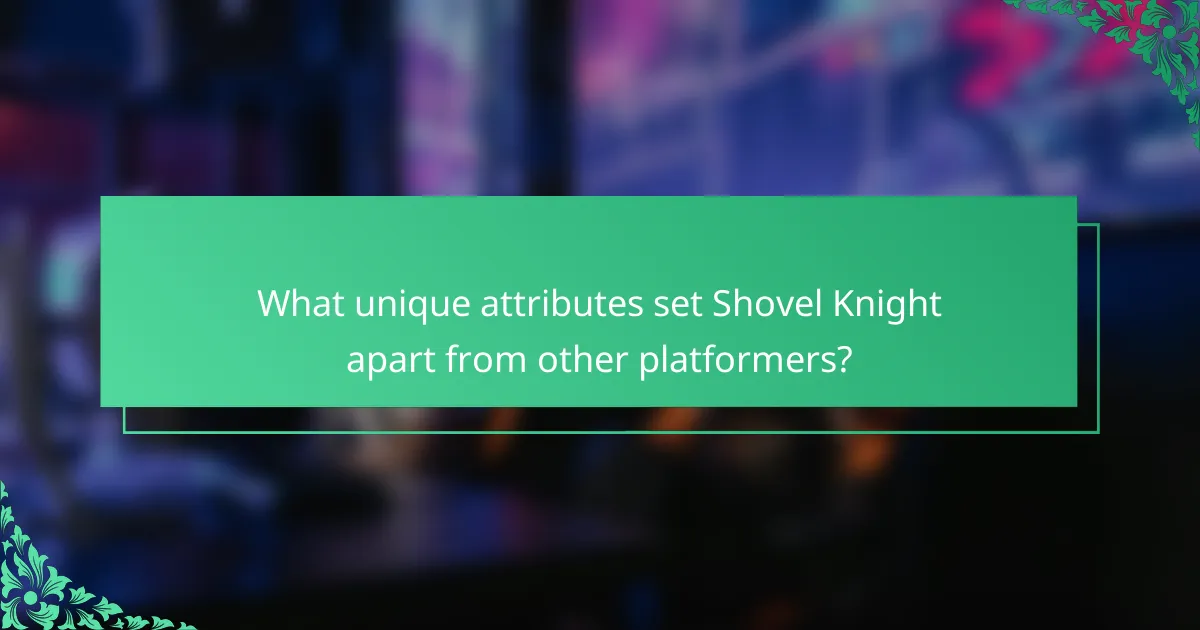
What unique attributes set Shovel Knight apart from other platformers?
Shovel Knight stands out from other platformers due to its unique gameplay mechanics, strategic relic usage, and dynamic enemy encounters. The gameplay combines classic platforming with modern design elements, creating a nostalgic yet fresh experience. Relic usage introduces varied abilities, such as the Phase Locket, allowing players to navigate challenges creatively. Additionally, enemy encounters are designed with distinct patterns and weaknesses, promoting strategic thinking and adaptability. These attributes collectively enhance the game’s depth, setting it apart in the platforming genre.
How does the art style contribute to the gameplay experience?
The art style enhances Shovel Knight’s gameplay by creating a visually engaging environment that complements mechanics. The pixel art evokes nostalgia, enriching player immersion. Each enemy design reflects their behaviour, aiding recognition during encounters. This synergy between visuals and gameplay mechanics fosters a cohesive experience, encouraging strategic relic usage.
What narrative elements are integrated into gameplay mechanics?
Shovel Knight integrates narrative elements into gameplay mechanics through character interactions, relic usage, and enemy encounters. These elements enhance the player experience by providing context and motivation.
The game features various relics that not only serve as tools but also deepen the storyline. For instance, the use of the Shovel Blade allows players to uncover hidden treasures, reinforcing the theme of exploration.
Enemy encounters are designed with distinct backstories, making battles feel more significant. Each foe has unique traits that connect to the overarching narrative, adding layers to the gameplay.
Overall, Shovel Knight’s mechanics intertwine story and play, creating a rich, immersive experience.
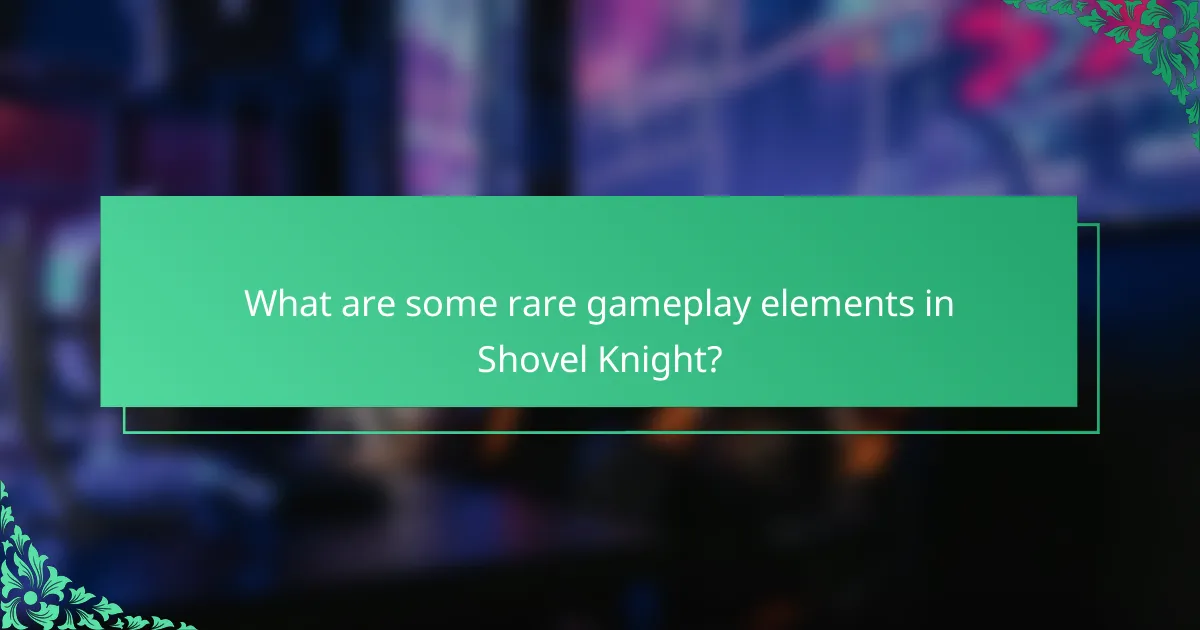
What are some rare gameplay elements in Shovel Knight?
Shovel Knight features rare gameplay elements that enhance the player’s experience. Unique relics like the Phase Locket allow invulnerability, while the Shovel Drop mechanic creates dynamic combat opportunities. Rare enemy encounters, such as the Phantom Striker, introduce unexpected challenges. Additionally, hidden areas reward exploration with unique power-ups. These elements contribute to the game’s distinct charm and replayability.
How do secret areas and hidden relics enhance replayability?
Secret areas and hidden relics significantly enhance replayability in Shovel Knight by rewarding exploration and mastery. Players discover new paths and collectibles, which unlock unique abilities and strategies. These elements encourage multiple playthroughs to uncover every secret and optimise character builds. The thrill of finding hidden relics adds depth to enemy encounters, as players can adapt their tactics based on the relics they acquire. This dynamic keeps the gameplay fresh and engaging, promoting a richer gaming experience.
What are the benefits of speedrunning in Shovel Knight?
Speedrunning in Shovel Knight enhances gameplay by promoting mastery of mechanics, efficient relic usage, and strategic enemy encounters. Players develop quick reflexes and problem-solving skills, improving overall gaming performance. Speedrunning fosters a community that shares strategies and techniques, enriching the gaming experience. Additionally, it encourages exploration of game mechanics, revealing unique attributes that may go unnoticed in casual play.
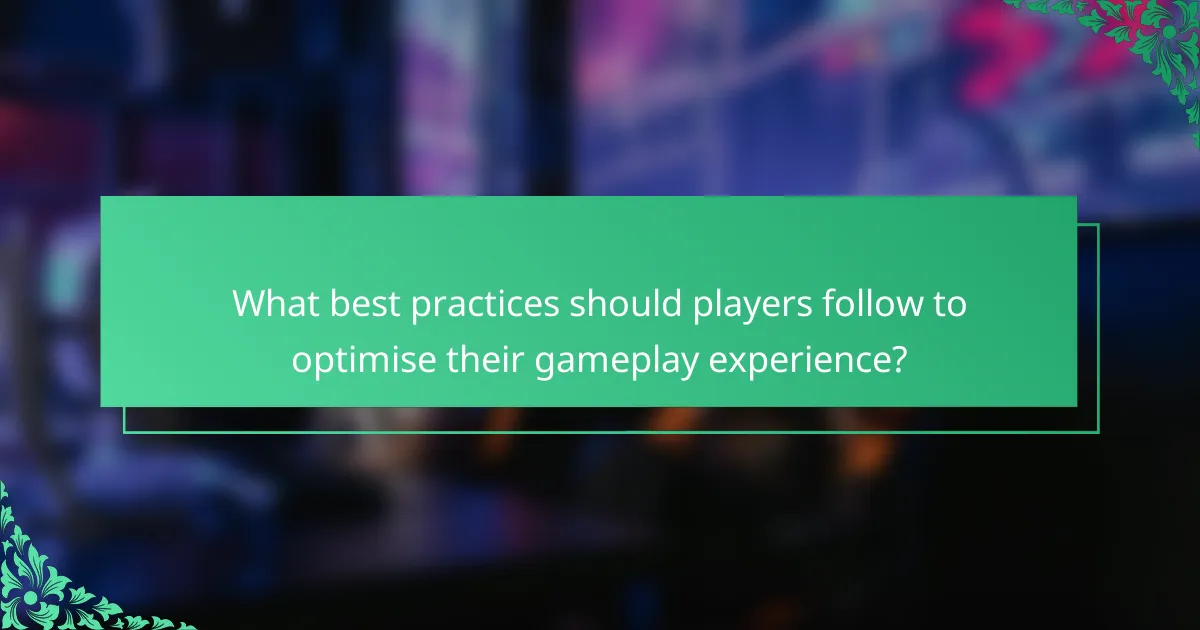
What best practices should players follow to optimise their gameplay experience?
To optimise gameplay experience in Shovel Knight, players should focus on mastering mechanics, efficient relic usage, and understanding enemy patterns.
Players should practice the jump and attack mechanics to enhance mobility and combat effectiveness. Timing attacks and using the shovel drop can maximise damage.
Relics offer unique abilities that can turn the tide in battles. Players should experiment with different relics to find the most effective combinations for their playstyle.
Understanding enemy encounters is crucial. Players should learn enemy attack patterns and weaknesses to strategise effectively during battles.
How can players effectively balance relic usage and combat strategies?
Players can balance relic usage and combat strategies by strategically selecting relics that enhance their abilities and adapting their approach based on enemy types. The key is to understand each relic’s unique attributes and how they complement various combat scenarios. For instance, using the Phase Locket can provide invulnerability during challenging enemy encounters, allowing players to focus on positioning and attack patterns. Additionally, players should assess the root attributes of enemies, such as attack styles and weaknesses, to choose relics that counter these effectively. Timing relic usage during combat can create openings for attacks, maximising damage output while minimising risk.
What common mistakes should players avoid during enemy encounters?
Players should avoid common mistakes like rushing into combat, neglecting relics, and ignoring enemy patterns. Proper timing and strategy are crucial for success.
Rushing into combat can lead to unnecessary damage. Players should analyse enemy behaviour before engaging. Neglecting relics limits available resources. Each relic has unique benefits that can turn the tide of battle. Ignoring enemy patterns results in missed opportunities for counterattacks. Understanding these patterns helps players anticipate moves and react effectively.
In summary, strategic planning, effective relic usage, and careful observation of enemy behaviour enhance gameplay and increase the chances of victory in Shovel Knight.
